

Compact Muon Solenoid
LHC, CERN
| CMS-PAS-SUS-16-041 | ||
| Search for new physics in events with multileptons and jets in 35.9 fb−1 of proton-proton collision data at √s= 13 TeV | ||
| CMS Collaboration | ||
| March 2017 | ||
| Abstract: A search for new physics is carried out in events with at least 3 electrons or muons and jets. Results are based on the sample of 35.9 fb−1 of proton-proton collision data produced by the LHC at a center-of-mass energy of 13 TeV and collected by the CMS experiment. Events are classified according to the number of b jets, missing transverse momentum, hadronic transverse energy, and the invariant mass of opposite-charge, same-flavor dilepton pairs. No significant excess above the standard model background expectation is observed. The results are interpreted using simplified models of supersymmetry. Exclusion limits are set in the context of four different simplified supersymmetric models with pair production of gluino or third generation squarks. In a model with gluino pair production, with subsequent decay into a top quark-antiquark pair and a neutralino, gluinos with masses smaller than 1610 GeV are excluded for light neutralinos. In a model with pair of bottom squarks production, the masses of sbottoms are excluded up to 840 GeV for light charginos. | ||
|
Links:
CDS record (PDF) ;
CADI line (restricted) ;
These preliminary results are superseded in this paper, JHEP 02 (2018) 067. The superseded preliminary plots can be found here. |
||
| Additional information on efficiencies needed for reinterpretation of these results are available here. Additional technical material for CMS speakers can be found here |
| Figures | |

png pdf |
Figure 1:
Diagrams for models involving gluino pair production leading to four top quarks (a), or four quarks and two vector bosons (b) in the final state, in both cases accompanied by two LSPs. Models of bottom and top squark pair production lead to two top quarks and, respectively, W bosons (c) or SM Higgs (H) or Z bosons (d). |

png pdf |
Figure 1-a:
Diagram for model involving gluino pair production leading to four top quarks in the final state, accompanied by two LSPs. |
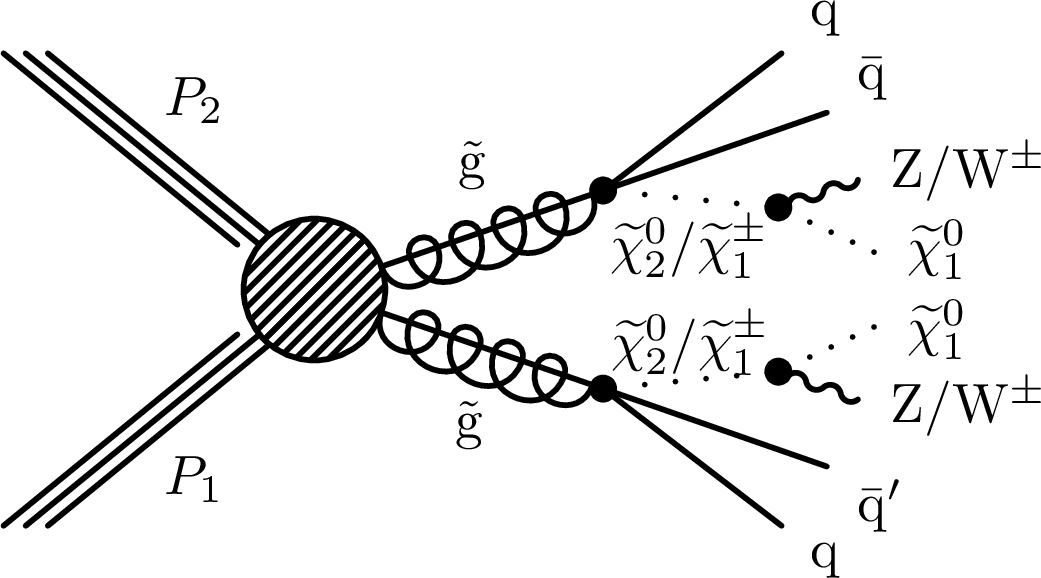
png pdf |
Figure 1-b:
Diagram for model involving gluino pair production leading to four quarks and two vector bosons in the final state, accompanied by two LSPs. |

png pdf |
Figure 1-c:
Model of bottom squark pair production leading to two top quarks and W bosons. |

png pdf |
Figure 1-d:
Model of top squark pair production leading to two top quarks and SM Higgs (H) or Z bosons. |

png pdf |
Figure 2:
Background prediction and observation in key observables of the off-Z baseline selection: the number of (b) jets, HT, MminT, EmissT, the distibutions of the lepton pT spectra, the flavor composition of the leptons, and the event yields in each flavour category in the event are shown. The hatched area represents the statistical and systematic uncertainties on the prediction. The lower panels show the ratio of observation to prediction. |

png pdf |
Figure 2-a:
Background prediction and observation, off-Z baseline selection: the number of jets.The hatched area represents the statistical and systematic uncertainties on the prediction. The lower panel shows the ratio of observation to prediction. |

png pdf |
Figure 2-b:
Background prediction and observation, off-Z baseline selection: the number of b jets.The hatched area represents the statistical and systematic uncertainties on the prediction. The lower panel shows the ratio of observation to prediction. |
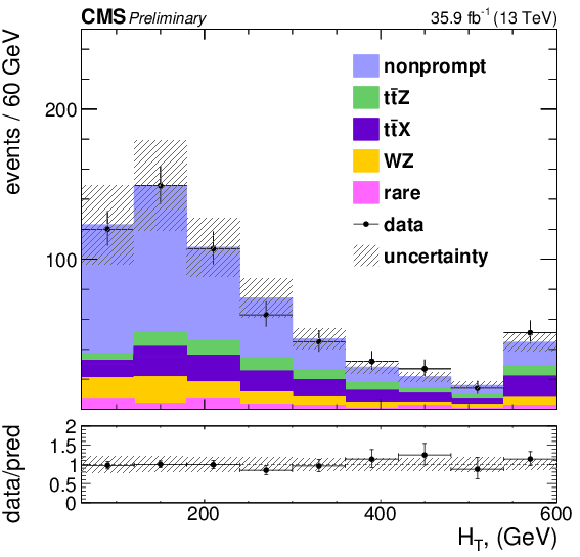
png pdf |
Figure 2-c:
Background prediction and observation, off-Z baseline selection: HT. The hatched area represents the statistical and systematic uncertainties on the prediction. The lower panel shows the ratio of observation to prediction. |

png pdf |
Figure 2-d:
Background prediction and observation, off-Z baseline selection: MminT. The hatched area represents the statistical and systematic uncertainties on the prediction. The lower panel shows the ratio of observation to prediction. |

png pdf |
Figure 2-e:
Background prediction and observation, off-Z baseline selection: EmissT. The hatched area represents the statistical and systematic uncertainties on the prediction. The lower panel shows the ratio of observation to prediction. |

png pdf |
Figure 2-f:
Background prediction and observation, off-Z baseline selection: leading lepton pT. The hatched area represents the statistical and systematic uncertainties on the prediction. The lower panel shows the ratio of observation to prediction. |
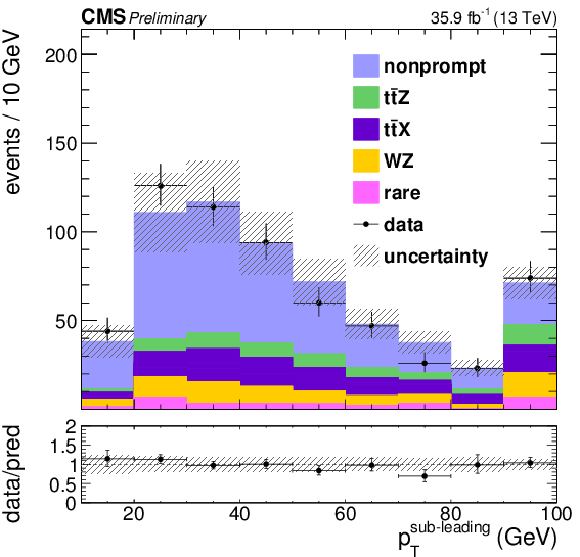
png pdf |
Figure 2-g:
Background prediction and observation, off-Z baseline selection: sub-leading lepton pT. The hatched area represents the statistical and systematic uncertainties on the prediction. The lower panel shows the ratio of observation to prediction. |

png pdf |
Figure 2-h:
Background prediction and observation, off-Z baseline selection: trailing lepton pT. The hatched area represents the statistical and systematic uncertainties on the prediction. The lower panel shows the ratio of observation to prediction. |

png pdf |
Figure 2-i:
Background prediction and observation, off-Z baseline selection: Event yields in each flavour category in the event. The hatched area represents the statistical and systematic uncertainties on the prediction. The lower panel shows the ratio of observation to prediction. |

png pdf |
Figure 3:
Background prediction and observation in key observables of the on-Z baseline selection: the number of (b) jets, HT, MminT, EmissT, the distibutions of the lepton pT spectra, the flavor composition of the leptons, and the event yields in each flavour category in the event are shown. The hatched area represents the statistical and systematic uncertainties on the prediction. The lower panels show the ratio of observation to prediction. |

png pdf |
Figure 3-a:
Background prediction and observation, on-Z baseline selection: the number of jets.The hatched area represents the statistical and systematic uncertainties on the prediction. The lower panel shows the ratio of observation to prediction. |

png pdf |
Figure 3-b:
Background prediction and observation, on-Z baseline selection: the number of b jets.The hatched area represents the statistical and systematic uncertainties on the prediction. The lower panel shows the ratio of observation to prediction. |

png pdf |
Figure 3-c:
Background prediction and observation, on-Z baseline selection: HT. The hatched area represents the statistical and systematic uncertainties on the prediction. The lower panel shows the ratio of observation to prediction. |

png pdf |
Figure 3-d:
Background prediction and observation, on-Z baseline selection: MminT. The hatched area represents the statistical and systematic uncertainties on the prediction. The lower panel shows the ratio of observation to prediction. |

png pdf |
Figure 3-e:
Background prediction and observation, on-Z baseline selection: EmissT. The hatched area represents the statistical and systematic uncertainties on the prediction. The lower panel shows the ratio of observation to prediction. |

png pdf |
Figure 3-f:
Background prediction and observation, on-Z baseline selection: leading lepton pT. The hatched area represents the statistical and systematic uncertainties on the prediction. The lower panel shows the ratio of observation to prediction. |

png pdf |
Figure 3-g:
Background prediction and observation, on-Z baseline selection: sub-leading lepton pT. The hatched area represents the statistical and systematic uncertainties on the prediction. The lower panel shows the ratio of observation to prediction. |

png pdf |
Figure 3-h:
Background prediction and observation, on-Z baseline selection: trailing lepton pT. The hatched area represents the statistical and systematic uncertainties on the prediction. The lower panel shows the ratio of observation to prediction. |

png pdf |
Figure 3-i:
Background prediction and observation, on-Z baseline selection: Event yields in each flavour category in the event. The hatched area represents the statistical and systematic uncertainties on the prediction. The lower panel shows the ratio of observation to prediction. |

png pdf |
Figure 4:
Background prediction and observation in the 23 off-Z signal regions and in the 23 on-Z signal regions. The hatched area represents the statistical and systematic uncertainties on the prediction. The lower panels show the ratio of observation to prediction. |
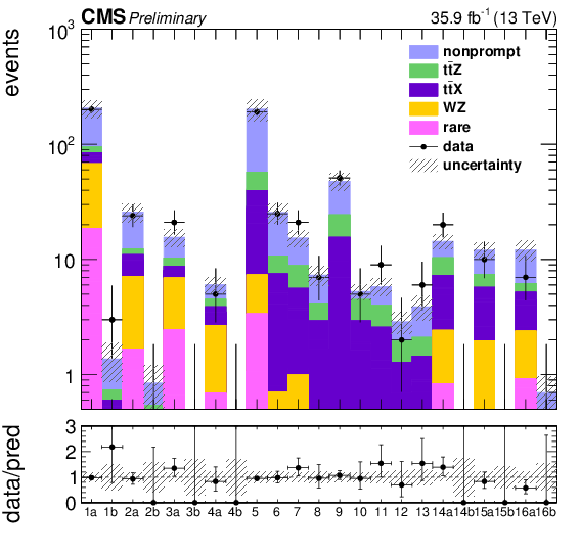
png pdf |
Figure 4-a:
Background prediction and observation in the 23 off-Z signal regions. The hatched area represents the statistical and systematic uncertainties on the prediction. The lower panel shows the ratio of observation to prediction. |

png pdf |
Figure 4-b:
Background prediction and observation in the 23 on-Z signal regions. The hatched area represents the statistical and systematic uncertainties on the prediction. The lower panel shows the ratio of observation to prediction. |

png pdf |
Figure 5:
Excluded region at 95% confidence in the m(˜χ0) versus m(˜g) plane for the simplified models of gluino pair production with four top quarks (a) and a VV + jets (b) in the final state. The excluded regions are to the left and below the observed and expected limit curves. The color scale indicates the excluded cross section at a given point in the mass plane. |

png pdf root |
Figure 5-a:
Excluded region at 95% confidence in the m(˜χ0) versus m(˜g) plane for the simplified models of gluino pair production with four top quarks in the final state. The excluded regions are to the left and below the observed and expected limit curves. The color scale indicates the excluded cross section at a given point in the mass plane. |

png pdf root |
Figure 5-b:
Excluded region at 95% confidence in the m(˜χ0) versus m(˜g) plane for the simplified models of gluino pair production with VV + jets in the final state. The excluded regions are to the left and below the observed and expected limit curves. The color scale indicates the excluded cross section at a given point in the mass plane. |

png pdf root |
Figure 6:
Excluded region at 95% confidence in the m(˜χ0) versus m(˜b) plane for the simplified models of ˜b pair production with two top quarks and two W boson + jets in the final state. The excluded regions are to the left and below the observed and expected limit curves. The color scale indicates the excluded cross section at a given point in the mass plane. |
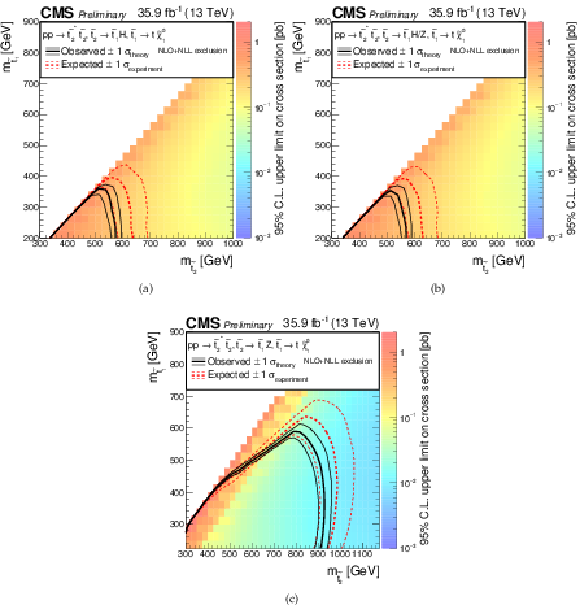
png pdf |
Figure 7:
Excluded region at 95% confidence in the m(˜t2) versus m(˜t1) plane for the simplified models of ˜t2 pair production with 2 top quarks and two Z or H boson + jets in the final state. Different branching ratio of the decay ˜t2→˜t1Z are considered: 0% (a), 50% (b) and 100% (c). The excluded regions are to the left and below the observed and expected limit curves. The color scale indicates the excluded cross section at a given point in the mass plane. |

png pdf root |
Figure 7-a:
Excluded region at 95% confidence in the m(˜t2) versus m(˜t1) plane for the simplified models of ˜t2 pair production with 2 top quarks and two Z or H boson + jets in the final state. Different branching ratio of the decay ˜t2→˜t1Z are considered: 0%. The excluded regions are to the left and below the observed and expected limit curves. The color scale indicates the excluded cross section at a given point in the mass plane. |

png pdf root |
Figure 7-b:
Excluded region at 95% confidence in the m(˜t2) versus m(˜t1) plane for the simplified models of ˜t2 pair production with 2 top quarks and two Z or H boson + jets in the final state. Different branching ratio of the decay ˜t2→˜t1Z are considered: 50%. The excluded regions are to the left and below the observed and expected limit curves. The color scale indicates the excluded cross section at a given point in the mass plane. |

png pdf root |
Figure 7-c:
Excluded region at 95% confidence in the m(˜t2) versus m(˜t1) plane for the simplified models of ˜t2 pair production with 2 top quarks and two Z or H boson + jets in the final state. Different branching ratio of the decay ˜t2→˜t1Z are considered: 100%. The excluded regions are to the left and below the observed and expected limit curves. The color scale indicates the excluded cross section at a given point in the mass plane. |
| Tables | |

png pdf |
Table 1:
Summary of all cuts used in baseline selection |

png pdf |
Table 2:
Summary of the definition of the signal regions. The minimum EmissT requirement is raised from 50 to 70 GeV only for on-Z SR1 and SR5. The dagger sign indicates signal regions that are further subdivided at MminT= 120 GeV. The search regions are mirrored in on- and off-Z region. |

png pdf |
Table 3:
Definition of super signal regions. A simpler classification is proposed for reinterpretations, depending on the presence of a Z candidate and the number of b jets, along with additional simultaneous requirements on MminT, EmissT and HT. |

png pdf |
Table 4:
Systematic uncertainties and their effect on the event yields of each affected process. |

png pdf |
Table 5:
Observed and expected yields in the off-Z search regions with the 35.9 fb−1 of data. The uncertainties shown are statistical then systematic. |

png pdf |
Table 6:
Observed and expected yields in the on-Z search regions with the 35.9 fb−1 of data. The uncertainties shown are statistical then systematic. |

png pdf |
Table 7:
Observed and expected yields in the super search regions with the 35.9 fb−1 of data. The uncertainties shown are statistical then systematic. |
| Summary |
|
A search for beyond the standard model physics in final states with ≥3 leptons, electrons or muons, using 35.9 fb−1 of data collected with the CMS detector in 2016 at √s= 13 TeV has been presented. The analysis makes use of control regions in data to estimate reducible backgrounds and to validate simulation for use in estimating irreducible background processes. To maximize sensitivity to a broad range of possible signal models, 46 exclusive signal regions have been investigated. No significant deviation from the expected standard model background has been observed. In the absence of any observed excesses in the data, the result has been interpreted using a simplified gluino-pair production model that features cascade decays producing four top quarks in the final state. In this model, we exclude gluinos with a mass of up to 1610 GeV in the case of a massless LSP. The maximum excluded LSP mass is 900 GeV. In both masses, this represents an improvement of the order of 435 GeV and 250 GeV, respectively, compared to the exclusion limit set in a similar search based on 2.3 fb−1 collected with the CMS detector in 2015 [15]. For the simplified model with gluino-gluino production and light jets and two vector bosons in the final state, gluino masses up to 1160 GeV and neutralino masses up to 650 GeV can be excluded. The limit on gluino mass for a light neutralino extends the corresponding limit from the previous analysis by about 335 GeV and 150 GeV, respectively. For simplified model for ˜b pair production ˜b masses up to 840 GeV is excluding in case of low mass of ˜χ±, while ˜χ± masses are excluded up to 740 GeV, which are extending by 390 and 440 GeV for both sparticles. And finally for top squarks pair production model with further decay into 2 top quarks and Higgs or Z boson, the˜t2 masses are excluded up to 580, 570 and 910 GeV for the models with the ˜t2→˜t1Z BR of 0%, 50% and 100% respectively, while ˜t1 masses are excluded up to 40, 10 and 300 GeV for the same branching ratios. |
| Additional Tables | |

png pdf |
Additional Table 1:
Cutflow table for the gluino pair production model with four top quarks in the final state, assuming gluino and LSP masses equal to 1500 and 200 GeV, respectively. The last two lines correspond to the most populated search regions. The yields correspond to the integrated luminosity of 35.9 fb−1 and the assumed cross section for this model is 0.0142 pb. |

png pdf |
Additional Table 2:
Cutflow table for the gluino pair production model with two vector bosons and light jets in the final state, assuming gluino and LSP masses equal to 1200 and 400 GeV, respectively. The last two lines correspond to the most populated search regions. The yields correspond to the integrated luminosity of 35.9 fb−1. The assumed cross section for this model is 0.0856 pb, with branching fraction values of 2/3 and 1/3 for ˜g→˜χ±qˉq′ and ˜g→˜χ02qˉq respectively. |
| References | ||||
| 1 | P. Ramond | Dual theory for free fermions | PRD 3 (1971) 2415 | |
| 2 | \relax Yu. A. Golfand and E. P. Likhtman | Extension of the algebra of Poincare group generators and violation of P invariance | JEPTL 13 (1971) 323.[Pisma Zh. Eksp. Teor. Fiz. \bf 13 (1971) 452] | |
| 3 | A. Neveu and J. H. Schwarz | Factorizable dual model of pions | Nucl. Phys. B 31 (1971) 86 | |
| 4 | D. V. Volkov and V. P. Akulov | Possible universal neutrino interaction | JEPTL 16 (1972) 438.[Pisma Zh. Eksp. Teor. Fiz. \bf 16 (1972) 621] | |
| 5 | J. Wess and B. Zumino | A lagrangian model invariant under supergauge transformations | PLB 49 (1974) 52 | |
| 6 | J. Wess and B. Zumino | Supergauge transformations in four-dimensions | Nucl. Phys. B 70 (1974) 39 | |
| 7 | P. Fayet | Supergauge invariant extension of the Higgs mechanism and a model for the electron and its neutrino | Nucl. Phys. B 90 (1975) 104 | |
| 8 | H. P. Nilles | Supersymmetry, supergravity and particle physics | PR 110 (1984) 1 | |
| 9 | S. P. Martin | A supersymmetry primer | in Perspectives on Supersymmetry II, G. L. Kane, ed., p. 1 2010 | hep-ph/9709356 |
| 10 | D. Alves et al. | Simplified models for LHC new physics searches | JPG 39 (2012) 105005 | 1105.2838 |
| 11 | ATLAS Collaboration | Search for supersymmetry at √s= 8 TeV in final states with jets and two same-sign leptons or three leptons with the ATLAS detector | JHEP 06 (2014) 035 | 1404.2500 |
| 12 | CMS Collaboration | Search for anomalous production of events with three or more leptons in pp collisions at √s= 8 TeV | PRD 90 (2014) 032006 | CMS-SUS-13-002 1404.5801 |
| 13 | CMS Collaboration | Searches for supersymmetry based on events with b jets and four W bosons in pp collisions at 8 TeV | PLB 745 (2015) 5 | CMS-SUS-14-010 1412.4109 |
| 14 | ATLAS Collaboration | Search for supersymmetry at √s = 13 TeV in final states with jets and two same-sign leptons or three leptons with the ATLAS detector | EPJC 76 (2016), no. 5, 259 | 1602.09058 |
| 15 | CMS Collaboration | Search for SUSY with multileptons in 13 TeV data | Submitted to \it EPJC | CMS-SUS-16-003 1701.06940 |
| 16 | CMS Collaboration | The CMS experiment at the CERN LHC | JINST 3 (2008) S08004 | CMS-00-001 |
| 17 | CMS Collaboration | Particle-flow event reconstruction in CMS and performance for jets, taus, and EmissT | CDS | |
| 18 | CMS Collaboration | Commissioning of the particle-flow event reconstruction with the first LHC collisions recorded in the CMS detector | CDS | |
| 19 | CMS Collaboration | Commissioning of the Particle-Flow Reconstruction in Minimum-Bias and Jet Events from pp Collisions at 7 TeV | CDS | |
| 20 | M. Cacciari, G. P. Salam, and G. Soyez | The anti-kt jet clustering algorithm | JHEP 04 (2008) 063 | 0802.1189 |
| 21 | CMS Collaboration | Identification of b-quark jets with the CMS experiment | JINST 8 (2013) P04013 | CMS-BTV-12-001 1211.4462 |
| 22 | CMS Collaboration | Performance of b tagging at sqrt(s)=8 TeV in multijet, tˉt and boosted topology events | CDS | |
| 23 | CMS Collaboration | Performance of CMS muon reconstruction in pp collision events at √s= 7 TeV | JINST 7 (2012) P10002 | CMS-MUO-10-004 1206.4071 |
| 24 | CMS Collaboration | Performance of Electron Reconstruction and Selection with the CMS Detector in Proton-Proton Collisions at √s= 8 TeV | JINST 10 (2015) P06005 | CMS-EGM-13-001 1502.02701 |
| 25 | CMS Collaboration | Performance of the missing transverse energy reconstruction by the CMS experiment in √s= 8 TeV pp data | Submitted to \it JINST | CMS-JME-13-003 1411.0511 |
| 26 | J. Alwall et al. | The automated computation of tree-level and next-to-leading order differential cross sections, and their matching to parton shower simulations | JHEP 07 (2014) 079 | 1405.0301 |
| 27 | T. Melia, P. Nason, R. Rontsch, and G. Zanderighi | W+W-, WZ and ZZ production in the POWHEG BOX | JHEP 11 (2011) 078 | 1107.5051 |
| 28 | T. Sjostrand, S. Mrenna, and P. Z. Skands | A Brief Introduction to PYTHIA 8.1 | CPC 178 (2008) 852 | 0710.3820 |
| 29 | CMS Collaboration | Event generator tunes obtained from underlying event and multiparton scattering measurements | EPJC 76 (2016) 155 | CMS-GEN-14-001 1512.00815 |
| 30 | GEANT4 Collaboration | Geant4−−a simulation toolkit | NIMA 506 (2003) 250 | |
| 31 | S. Abdullin et al. | The fast simulation of the CMS detector at LHC | J. Phys. Conf. Ser. 331 (2011) 032049 | |
| 32 | W. Beenakker et al. | Production of charginos, neutralinos, and sleptons at hadron colliders | PRL 83 (1999) 3780 | hep-ph/9906298 |
| 33 | A. Kulesza and L. Motyka | Threshold resummation for squark-antisquark and gluino-pair production at the LHC | PRL 102 (2009) 111802 | 0807.2405 |
| 34 | A. Kulesza and L. Motyka | Soft gluon resummation for the production of gluino-gluino and squark-antisquark pairs at the LHC | PRD 80 (2009) 095004 | 0905.4749 |
| 35 | W. Beenakker et al. | Soft-gluon resummation for squark and gluino hadroproduction | JHEP 12 (2009) 041 | 0909.4418 |
| 36 | W. Beenakker et al. | Squark and gluino hadroproduction | Int. J. Mod. Phys. A 26 (2011) 2637 | 1105.1110 |
| 37 | J. Butterworth et al. | PDF4LHC recommendations for LHC Run II | JPG43 (2016) 023001 | 1510.03865 |
| 38 | T. Junk | Confidence level computation for combining searches with small statistics | NIMA 434 (1999) 435 | hep-ex/9902006 |
| 39 | A. L. Read | Presentation of search results: The CLs technique | JPG 28 (2002) 2693 | |
| 40 | ATLAS and CMS Collaborations | Procedure for the LHC Higgs boson search combination in summer 2011 | CMS-NOTE-2011-005 | |

|
Compact Muon Solenoid LHC, CERN |

|

|

|

|

|

|